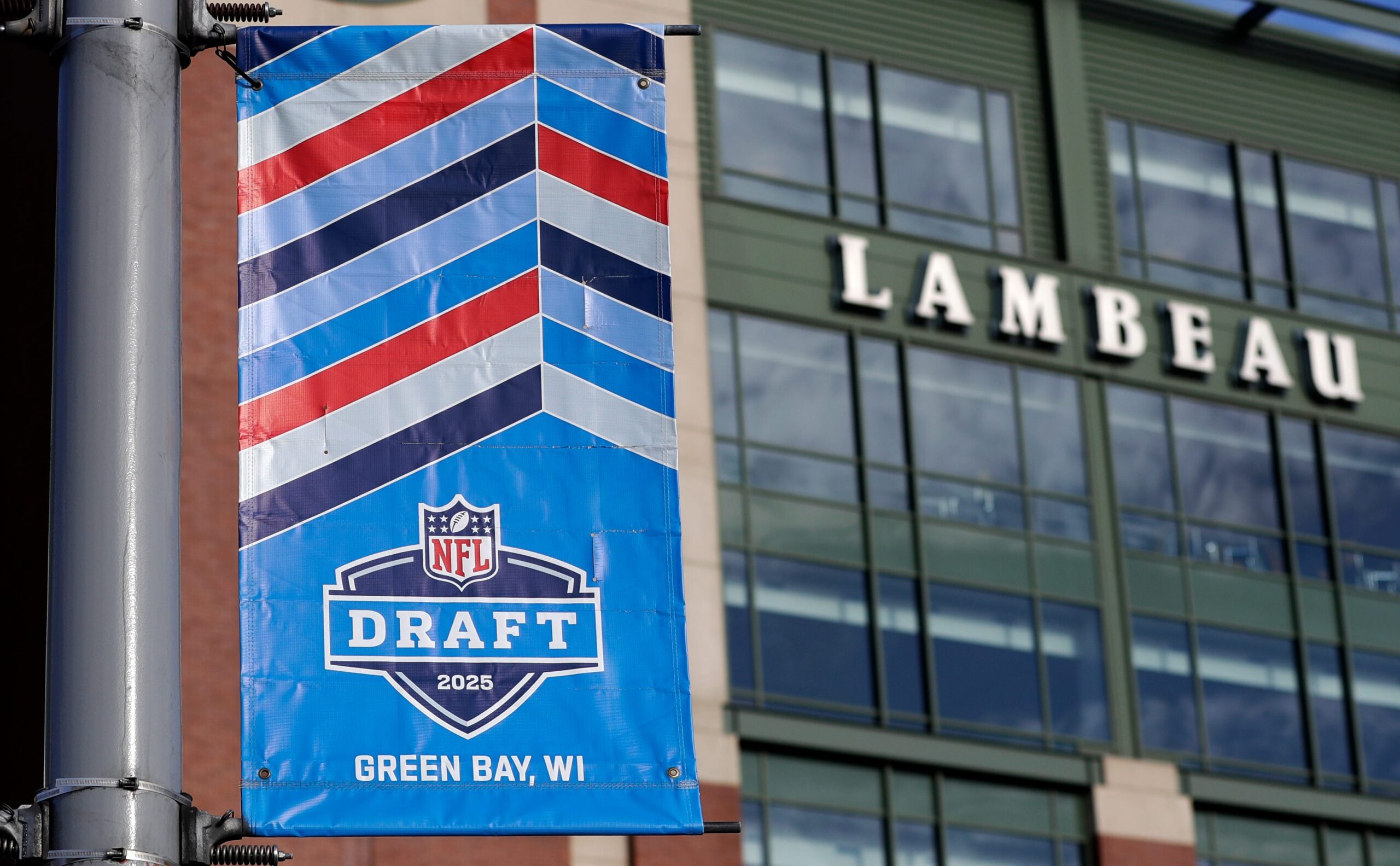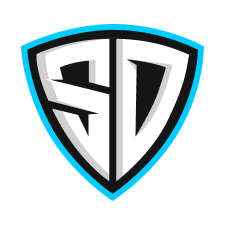Every NFL mock draft will be irrelevant in just a few hours when the real draft kicks off (April 23 at 8 p.m. ET, ESPN).
Here are the previous editions of my mock draft:
- Version 1: Before the national title game
- Version 2: After the Super Bowl
- Version 3: After free agency
With my 2019 NFL mock draft, I had top-20 scores in the FantasyPros Accuracy Contest and the Mock Draft Database Contest.
I also would have officially had a top-10 score in the Huddle Report Contest, but the invitation emails they sent went to my spam folder. I’ll be in the contest this year.
This mock draft more or less represents how I imagine Round 1 will unfold.
The three aforementioned contests all measure accuracy differently. The same mock could rank in the top three and outside the top 20 in two different contests. So I’m not too focused on the particular scoring details of any given contest. Instead, I’m focused on accomplishing the following tasks:
- Put as many likely first-rounders as possible in my draft.
- Match players with teams relatively likely to draft them.
- Mock players within their probable draft range.
- Order players accurately by position.
If you were to do a mock, you might go through it pick-by-pick trying to match each player perfectly with his team and draft position. That’s not the way I conceptualize a mock. To me, it’s not an exercise in attempted sequential perfection. I know I can’t do a perfect mock. I’m just trying to create a mock that is good enough.
For almost any player after pick No. 1, it’s hard to get everything about his draft situation right — and so I don’t try to get everything right. Instead, I try to maximize my odds of being right about the generalities.
And if, in hitting the generalities, I happen to get the particulars, then that’s great. But I don’t shoot for perfection. I shoot for sufficiency.
You’ll notice that I don't have any trades in the mock. There are two main reasons for that.
- Trades are almost impossible to predict, so I’d rather not try. My sense is that I’ll be more inaccurate overall if I try to have an accurate number of Round 1 trades in the mock.
- Because the 2020 draft will be done remotely due to the coronavirus, I expect there will be fewer trades than usual.
Mock Updates
Here are some scheduling notes related to how various versions of my mock will by graded by the industry.
- The version published and broken down here is the one officially graded by Huddle Report and Mock Draft Database, both of which have deadlines the night before Round 1.
- Today, I will likely post updated versions of my mock on Twitter and link to those tweets here. The last of these updated mocks is the one that will be graded by FantasyPros, which has an 8 p.m. ET deadline on draft day.
UPDATE (3 p.m. ET): I've posted an updated mock on Twitter. It might be my favorite version yet. I've corrected (I think) some of the shortcomings from the version below. Here are some notes.
- I've switched the draft orders for quarterbacks Tua Tagovailoa (Alabama) and Justin Herbert (Oregon). I once again have Tagovailoa going to the Miami Dolphins and Herbert going to the Los Angeles Chargers.
- I've bumped offensive tackle Austin Jackson (USC) up to No. 18 and added more hog mollies to Round 1, namely Ezra Cleveland (Boise State) and Isaiah Wilson (Georgia).
- To make room for Cleveland and Wilson, I've jettisoned two players from Round 1: Edge rusher A.J. Epenesea (Iowa) and quarterback Jordan Love (Utah State).
- Throughout the mock process, I've been too slow to move wide receiver Brandon Aiyuk (Arizona State) into Round 1. I've finally rectified that in this updated version.
If you're looking for more mock drafts, Scott Smith, the No. 1 mock ranker over the past two years at Mock Draft Database, wrote the final version of his projections for The Action Network.
2020 NFL Mock Draft
1. Bengals: Joe Burrow, QB, LSU
- Position: QB | School: LSU
- Height: 6’3” | Weight: 221 pounds
- 2020 Age: 24 | Class: Redshirt Senior
- Recruitment Stars: 4
- Projected Draft Round: 1
The Bengals need a quarterback, and Burrow just had the greatest passing season ever for a collegiate quarterback with 5,671 yards and 60 touchdowns to six interceptions. His 76.3% completion rate and 12.5 adjusted yards per attempt (AY/A) were immaculate.
Read more about Burrow's long-term fantasy potential.
2. Redskins: Chase Young, EDGE, Ohio State
- Height: 6’5” | Weight: 264 pounds
- 2020 Age: 21 | Class: Junior
- Recruitment Stars: 5
- Projected Draft Round: 1
For the third time in five years, we’re going to see a Buckeyes pass rusher selected with a top-three pick. Like Joey Bosa (2016, No. 3) and Nick Bosa (2019, No. 2) before him, Young will be the first non-quarterback off the board in his class.
And if circumstances were a little different, it wouldn’t have been a stretch to see him go No. 1 overall. As an edge defender, Myles Garrett (2017) did even though his class had three strong quarterback prospects in Patrick Mahomes, Deshaun Watson and Mitchell Trubisky.
In his standout junior season, Young had 16.5 sacks in 12 games and ranked No. 1 at his position with a 96.1 Pro Football Focus grade. Per PFF: “Young is the best edge prospect we’ve ever scouted.”
The unanimous All-American selection is as close as it gets to a top-two lock.
NFL Draft Betting Promotions
- Get 2-1 Odds on This 99.9% Joe Burrow Draft Prop
- Get a Huge Edge By Betting Tua to Be the Second QB Taken
- Get a 20% Boost on 2 NFL Draft Bets for FREE!
3. Lions: Jeff Okudah, CB, Ohio State
- Height: 6’1” | Weight: 205 pounds
- 40-yard dash: 4.48 seconds
- 2020 Age: NA | Class: Junior
- Recruitment Stars: 5
- Projected Draft Round: 1
A few sharp drafters have mocked defensive tackle Derrick Brown (Auburn) to the Lions, who could certainly use help on the interior of their defensive line, but Okudah is the strong chalk at No. 3 and too much of a difference-making player and value to forego at this pick.
Last year, the Lions allowed a league-high 503.2 air yards and yards after the catch per game (per AirYards.com), and they traded away No. 1 cornerback Darius Slay this offseason. Even though they signed Desmond Trufant in free agency, they still need significant help in the secondary.
Okudah is a unanimous All-American selection and easily the top perimeter defender in the class: He held opponents to a passer rating of just 45.3 last year (per PFF).

At the combine he exhibited elite explosiveness with his 41-inch vertical and 135-inch broad jumps, and based on his college production and athleticism, the player to whom Okudah is most comparable as a prospect is Jalen Ramsey (per Player Profiler).
The Lions might desire to trade down 2-3 spots in order to pick up more draft capital, but I’m doubtful they will be able to find a trade partner: Based on the general market, quarterbacks Tua Tagovailoa (Alabama) and Justin Herbert (Oregon) seem likely to fall to picks Nos. 5-6 if the Miami Dolphins and Los Angeles Chargers simply stay put.
And, besides, even if the Lions trade down 2-3 picks, they’re still likely to get Okudah, so wouldn’t I just mock him to them at No. 3?
4. Giants: Tristan Wirfs, OT, Iowa
- Height: 6’5” | Weight: 320 pounds
- 40-yard dash: 4.85 seconds
- 2020 Age: 21 | Class: Junior
- Recruitment Stars: 4
- Projected Draft Round: 1
This pick (I believe) is almost a 50/50 tossup between Wirfs and tackle Jedrick Wills Jr. (Alabama), but I lean just a little to Wills — at least right now.
The Giants might go with linebacker Isaiah Simmons (Clemson). Despite signing Blake Martinez to a three-year deal, they still need help at the position.
But they also need help on the offensive line. Left tackle Nate Solder is 32 years old, and right tackle Mike Remmers left in free agency.
The Giants just invested the No. 6 pick last year in quarterback Daniel Jones, and the organizational priority should be to give their developing passer as much offensive support as possible.
Picking at No. 4, they can get the top tackle in a strong draft class to protect their franchise quarterback, and general manager Dave Gettleman has tended to draft trench players when given the opportunity.
A three-year starter at a school with a history of producing NFL offensive linemen, Wirfs has an elite combination of strength and technique, and he exploded at the combine with position-best 36.5-inch vertical and 121-inch broad jumps.
There are questions as to whether Wirfs can play on the left side in the NFL, but at worst he looks like a top-tier right tackle, where he can line up before eventually replacing Solder on the blindside.
5. Dolphins: Justin Herbert, QB, Oregon
- Height: 6’6” | Weight: 236 pounds
- 40-yard dash: 4.68 seconds
- 2020 Age: 22 | Class: Senior
- Recruitment Stars: 3
- Projected Draft Round: 1
In my previous mock, I had Tagovailoa going to the Dolphins at No. 5, but I also said that "the Herbert heat is starting to pick up: There’s a chance that next week I’ll have him going to the Dolphins at No. 5 instead of Tagovailoa."
And that's where we are now.
There are rumors that the Dolphins might take an offensive tackle at No. 5 and look to draft a quarterback later in Round 1, but if they like a quarterback in particular — and there are real reports that they like Herbert and prefer him to Tagovailoa — then I doubt they will risk losing him.
Every reputable expert I've looked at has the Dolphins going with a quarterback at No. 5, and although it's 50/50 between Tagovailoa and Herbert across the industry, most of the sharpest mockers are on Herbert.
As a prospect, I easily prefer Tagovailoa over Herbert — it's not even close — but sometimes bad organizations make bad decisions. That's why they're bad.
Read more about when to take Herbert in rookie dynasty drafts.

6. Chargers: Tua Tagovailoa, QB, Alabama
- Height: 6’0” | Weight: 217 pounds
- 2020 Age: 22 | Class: Junior
- Recruitment Stars: 5
- Projected Draft Round: 1
For the first time in 14 years, the Chargers will head into the season with someone other than Philip Rivers as their starting quarterback. Rivers is now with the Indianapolis Colts, and head coach Anthony Lynn has indicated that journeyman Tyrod Taylor is penciled in as the starter.
In other words, the Chargers are very much in the market for a quarterback of the future, and Tagovailoa looks like he could fall to them at No. 6.
If the Dolphins prefer Herbert or are worried about Tagovailoa's medicals, then the Chargers might be as well, and that could drive them to take someone else, maybe Clemson's Justin Simmons at linebacker or one of the top remaining offensive tackles.
But I think they'll probably take Tagovailoa if he's here.
Tagovailoa entered the 2019 college season as the presumptive No. 1 pick, but a potentially career-threatening hip injury in November has drastically changed his draft outlook.
His talent is unquestioned: In his abbreviated junior campaign, Tagovailoa completed 71.4% of his passes and had an elite 13.4 AY/A.
But multiple teams reportedly are worried about Tagovailoa’s health.
https://t.co/rYm5U1TEgXpic.twitter.com/baIJLb23gS
— Michael Lombardi (@mlombardiNFL) April 8, 2020
He has dealt with all manner of injuries over the past two years (broken finger, sprained knee, strained quad, twisted ankles, dislocated and fractured hip). More than a few NFL evaluators reportedly believe that Tagovailoa is fragile. Brittle. Too small to be a dependable starter.
And that might be the case.
But he's worth the risk at No. 6.
Read more about when you should draft Tagovailoa in dynasty.
NFL Draft Betting Picks
- Our Favorite Value Bets for the 2020 NFL Draft
- Best Longshot Bets for the NFL Draft
- Our Staff's Favorite Quarterback Props for the 2020 NFL Draft
- The 10 Offensive Line NFL Draft Props Worth Betting Thursday
7. Panthers: Isaiah Simmons, LB, Clemson
- Height: 6’4” | Weight: 238 pounds
- 40-yard dash: 4.39 seconds
- 2020 Age: 22 | Class: Redshirt Junior
- Recruitment Stars: 3-4
- Projected Draft Round: 1
The Panthers have a lot of needs: Last year, they started a sixth-round rookie on the blind side. In previous versions of the mock, I had them going with an offensive lineman, but this offseason they acquired left tackle Russell Okung via trade, so there's now less urgency for them to improve the line in Round 1.
As a result, I expect the Panthers will look to the defense at No. 7, with the pick ultimately coming down to Simmons or DT Derrick Brown (Auburn). Between these two players, I must go with Simmons.
Simmons has the higher rating in Gil Brandt's Hot 150, Daniel Jeremiah's Top 150, Josh Norris' Top 150, The Draft Network's prospect rankings, and PFF's Big Board.
He's also the higher-mocked player at Grinding the Mocks.
The Panthers need help on the interior of their defensive line, but they also need an off-ball linebacker after franchise mainstay Luke Kuechly retired this offseason.
And as good as Brown is, he's not as dynamic as Simmons, who led Clemson in 2019 with 104 tackles, 16.5 tackles for loss and eight sacks — despite lining up as a safety or cornerback on 49.5% of his snaps (per PFF).
The 2019 Butkus Award winner and a unanimous All-American selection, Simmons is a versatile middle-of-the-field defender who can stop the run, rush the passer and cover running backs and tight ends.
His potential is almost otherworldly: "Simmons played 100 or more snaps at edge defender, linebacker, strong safety, free safety and slot cornerback, all while grading out above 80.0 as a run defender, tackler, pass rusher and coverage defender" (per PFF).
With his elite combine performance, Simmons has seemingly locked himself into the top 10.
Isaiah Simmons was 6'4" and 238 pounds at the combine and ran a 4.39-second 40-yard dash.
Based on those numbers, which draft prospect do you think he is most physically comparable to from the past 20 years? pic.twitter.com/uCOYMTNu8G
— Matthew Freedman (@MattFtheOracle) March 5, 2020
Of all the prospects from the past two decades, the guy to whom Simmons is most physically similar — based on their combine performances — is all-world wide receiver Calvin Johnson (6-foot-5, 239 pounds, 4.35-second 40-yard dash).
Simmons could experience a Derwin James-esque Round 1 slide, but the NFL would be foolish to let a player of his talent fall down the board.

8. Cardinals: Derrick Brown, DT, Auburn
- Height: 6’5” | Weight: 326 pounds
- 40-yard dash: 5.16 seconds
- 2020 Age: 22 | Class: Senior
- Recruitment Stars: 5
- Projected Draft Round: 1
In the previous version of the mock, I had the Cardinals going with an offensive tackle (Jedrick Wills Jr.), but the Cardinals are reportedly smitten with Brown, so if he falls to them at No. 8, there's a decent chance they'll take him. He'll certainly add some muscle to the interior of their defensive line.
A unanimous All-American selection and locker-room leader, Brown is perhaps the best run defender in the class, and his steadiness is likely to appeal to the Cardinals, who ranked No. 26 last year with a PFF defense grade of 62.6.
Although he’s not much of a sack artist — he had just four quarterback takedowns last year — Brown is sufficiently disruptive as a pass rusher, and over the past two seasons, he has earned top-10 PFF grades at the position.
Because he’s not an elite interior pass rusher, I doubt Brown will ever be an All-Pro player, but he seems likely to be an above-average and reliable long-term starter, and for an organization that needs to ensure it doesn’t draft a bust, that’s probably good enough.
9. Jaguars: Javon Kinlaw, DT, South Carolina
- Height: 6’5” | Weight: 324 pounds
- 2020 Age: 23 | Class: Senior
- Recruitment Stars: 4
- Projected Draft Round: 1
This is early for Kinlaw, whom Jacksonville might be able to get if they trade back, but I can see the Jags drafting him if they stay at No. 9.
The Jags could use an upgrade on the interior of the line. Last year they were No. 31 against the run in Football Outsiders’ DVOA metric, and Kinlaw should help.
A junior college transfer with a notable nasty streak, Kinlaw has three years of starting experience in the SEC, and relative to Brown, he might be the more complete player. Kinlaw can disrupt as a pass rusher and anchor well enough against the run. He probably has the greater physical talent.
But Kinlaw is also inconsistent, and he has average-at-best technique. Far too often, he is beaten by inferior offensive linemen.
I’m not an expert when it comes to pigskin trench warfare, but to my untrained eye, Kinlaw is a classic boom-or-bust prospect — and that feels like the kind of guy the Jags would draft high in Round 1.
[The Tua Bet that Could Crush One Sportsbook]
10. Browns: Andrew Thomas, OT, Georgia
- Height: 6’5” | Weight: 315 pounds
- 40-yard dash: 5.22 seconds
- 2020 Age: 21 | Class: Junior
- Recruitment Stars: 4-5
- Projected Draft Round: 1
The Browns need to improve their protection for third-year quarterback Baker Mayfield, and despite stealing right tackle Jack Conklin away from the Tennessee Titans with a three-year deal, they still need to upgrade their offensive line.
Left tackle Greg Robinson is a free agent, and after he was arrested by border patrol in February with a human-sized amount of marijuana …
Browns offensive tackle Greg Robinson alleged to have 157 pounds of marijuana in his rental car. This is what 157 pounds of pot looks like. It has a street value of in between $300,000 and $750,000, depending on quality and location of sale. pic.twitter.com/1CZ4hZHEIr
— Darren Rovell (@darrenrovell) February 20, 2020
… I doubt the Browns will wish to re-sign him.
Enter Thomas: A three-year starter with experience at both tackle spots and a unanimous All-American selection to his name. An above-average run blocker and solid pass blocker, Thomas is technically sound and used to playing in a pro scheme.
Jedrick Wills Jr. is an option to go here, but he played only right tackle in college, and given that the Browns already have Conklin, I could see them going with Thomas, who has played at left tackle for the past two years.
Thomas has the potential to be the true heir to future Hall-of-Famer Joe Thomas’ long-vacant franchise tackle throne, and on the left side, he could form a commanding combo with Pro-Bowl guard Joe Bitonio.
11. Jets: Jedrick Wills Jr., OT, Alabama
- Height: 6’4” | Weight: 312 pounds
- 40-yard dash: 5.05 seconds
- 2020 Age: 21 | Class: Junior
- Recruitment Stars: 4-5
- Projected Draft Round: 1
The Jets seem likely to take either an offensive tackle or a wide receiver, and although they can get their pick of receivers at No. 11, I lean toward a tackle with this selection.
The Jets are incredibly weak on the offensive line, and they look like they'll be without starting tackles Kelvin Beachum and Brandon Shell: Beachum is still a free agent, and Shell signed with the Seattle Seahawks this offseason.
The Jets need to give 2018 first-rounder and hoped-for franchise quarterback Sam Darnold as much protection as possible, and Wills has as much upside as any tackle in the draft. A two-year starter and first-team All-SEC selection last season, Wills has elite agility and strength and can win as both a pass protector and run blocker.
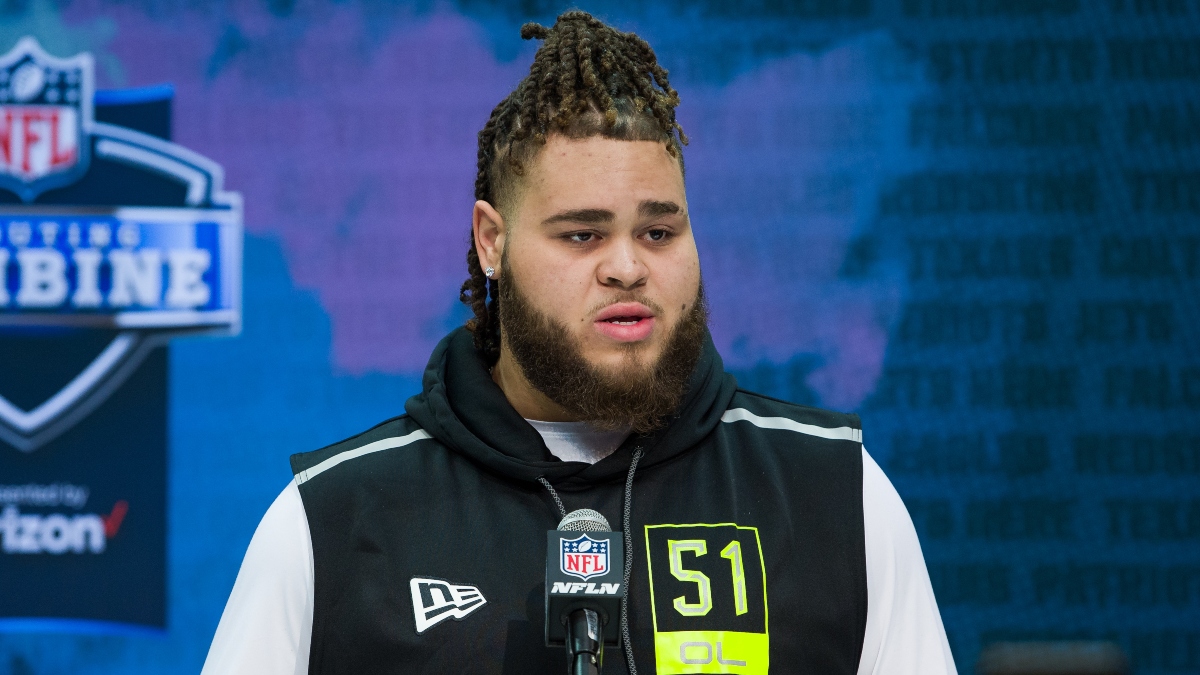
Some evaluators knock Wills because he played only at right tackle in college, but at Alabama he served as the left-handed Tagovailoa's blindside protector: He's not a typical heavy-footed run-game bulldozer.
There's a decent chance Wills could go at No. 4 to the Giants, so the Jets are getting great value with him at No. 11.
12. Raiders: CeeDee Lamb, WR, Oklahoma
- Height: 6’2” | Weight: 198 pounds
- 40-yard dash: 4.50 seconds
- 2020 Age: 21 | Class: Junior
- Recruitment Stars: 4
- Projected Draft Round: 1
With Tyrell Williams, Hunter Renfrow, Zay Jones and Nelson Agholor, the Raiders have the league's least inspiring wide receiver unit.
They need a receiver, and Lamb is a strong option as the No. 1 guy off the board.
A first-team All-American selection, Lamb might be the best receiver in the class. In comparison to Jerry Jeudy (Alabama), he's bigger, more aggressive and maybe more dynamic after the catch. And with back-to-back years of 1,000-plus yards and double-digit touchdowns, he is just as productive as Jeudy.
Read more about how to size up Lamb heading into dynasty rookie drafts.
13. 49ers*: Henry Ruggs III, WR, Alabama
- Height: 5’11” | Weight: 188 pounds
- 40-yard dash: 4.27 seconds
- 2020 Age: 21 | Class: Junior
- Recruitment Stars: 4-5
- Projected Draft Round: 1
*Pick via Colts
The 49ers could do almost anything at No. 13. They have a strong roster top to bottom and can afford to draft for value instead of need.
But after losing wide receiver Emmanuel Sanders in free agency, the 49ers could easily take a receiver here, and at No. 13, they can get a quality player.
Ruggs is what the 49ers hoped Marquise Goodwin would be. And given that Goodwin had 1,006 yards in 2017 while playing most of his games with quarterbacks Brian Hoyer and C.J. Beathard, the upside for Ruggs is incredibly high in head coach Mike Shanahan's offensive system.
While No. 13 might feel early for Ruggs, especially with Jeudy still on the board, there's a real chance that the 49ers prefer Ruggs to Jeudy. Plus, there's a chance that another team — maybe the Broncos — will trade up and take Jeudy before the 49ers are on the clock.
Over the past four years — essentially, since speedster Tyreek Hill's rookie season — the NFL has privileged speed at the wide receiver position, and as a result, we’ve seen fast receivers go off the board early.
- 2019: Marquise Brown, 1.25 (1st) – No pre-draft workout because of injury, reportedly ran a 4.33 as a junior college recruit
- 2018: D.J. Moore, 1.24 (1st) – 4.42 at 210 pounds
- 2017: John Ross, 1.10 (3rd) – 4.22 at 188 pounds
- 2016: Corey Coleman, 1.15 (1st) – 4.37 at 194 pounds (pro day)
Unlike Brown, Moore, Ross and Coleman, the electric Ruggs never had a breakout season in college, but I'm not faulting him for that. With Alabama's assortment of pass-catching talent and offensive dominance, Ruggs was never called upon to be an alpha receiver, but for his career, he turned 100 touches from scrimmage into 1,791 yards and 25 touchdowns.
That's elite efficiency, and he is a better receiver than most numbers-based analysts think: Ruggs is an above-average route runner with strong contested-catch skills for his size, and his elite deep speed makes him a threat to score whenever he touches the ball. For his career, he gifted his quarterbacks with a 151.4 passer rating when targeted (per PFF).
Because of how he forces defenses to play him, Ruggs ultimately might be more valuable to his NFL team than his fantasy franchises, but I still like him for dynasty.
Read more about how to approach Ruggs in rookie drafts.

14. Buccaneers: Mekhi Becton, OT, Louisville
- Height: 6’7” | Weight: 364 pounds
- 40-yard dash: 5.10 seconds
- 2020 Age: 21 | Class: Junior
- Recruitment Stars: 3-4
- Projected Draft Round: 1
One way or another — whether they trade up or a player falls down the board — I expect the Bucs to get one of the top-four tackles to protect new quarterback Tom Brady.
The Bucs have a clear need on the offensive line: Right tackle Demar Dotson will turn 35 years old this year, and he’s a free agent. If they draft Becton, the Bucs could start him out at right tackle and then move him over to the blindside after a couple of seasons: Left tackle Donovan Smith's contract expires in 2022.
I like Becton a lot: He has the unlimited power and force-sensitive quickness of Emperor Palpatine and the body of Jabba the Hutt.
A three-year starter with experience at both tackle spots, Becton has seen his draft stock skyrocket since his unbelievable performance at the combine.
He's also seen his draft stock drop a little because of a flagged drug test at the combine. Even so, I still expect him to be selected in the top half of Round 1.
Becton is raw in pass protection, but he has the length to be an elite blindside protector, and his overwhelming dominance as a run blocker is unparalleled in the class.
He could be a decade-long starter.
[Where to Bet NFL Draft Props]
15. Broncos: Jerry Jeudy, WR, Alabama
- Height: 6’1” | Weight: 193 pounds
- 40-yard dash: 4.45 seconds
- 2020 Age: 21 | Class: Junior
- Recruitment Stars: 4-5
- Projected Draft Round: 1
The Broncos need a wide receiver after trading away Emmanuel Sanders in the middle of the 2019 season, and this class is loaded at the position. They reportedly like Jeudy the most of the receiver group, so whether they take him at No. 15 or trade up for him, I think there's a decent chance they get him.
Although I have Jeudy mocked here as the No. 3 receiver off the board, I want to be clear that I have a very high opinion of him. Jeudy is a complete receiver. He might never be an All-Pro producer, but he does everything well. He's a smooth route runner with good hands. He plays inside and outside. He can go deep and across the middle of the field. When he has faced press coverage, he's usually been able to beat it.
For two years, Jeudy has been the No. 1 receiver in an offense that might have four first-round wideouts who all get regular playing time. That's incredible.
With a Fred Biletnikoff Award as the nation’s top receiver in 2018 and back-to-back seasons of 1,000-plus yards and 10-plus touchdowns receiving, Jeudy is a priority for dynasty.
Read more about how Jeudy projects for rookie drafts.
16. Falcons: C.J. Henderson, CB, Florida
- Height: 6’1” | Weight: 204 pounds
- 40-yard dash: 4.39 seconds
- 2020 Age: 22 | Class: Junior
- Recruitment Stars: 4
- Projected Draft Round: 1
By hook or by crook, the Falcons are getting Henderson. Also, I have no idea what "by hook or by crook" literally means, but I think I used it correctly. I expect that the Falcons will ultimately trade up to get Henderson, but I can also see how he'd fall to No. 16 with the run on offensive tackles and wide receivers.
He makes a lot of sense for the Falcons.
For years, their problem has been defense. Ex: Their epic Super Bowl 51 collapse. If they had managed to get just one stop in the fourth quarter — just one! — "28-3" wouldn't mean anything to anyone.

The Falcons absolutely must improve on defense, and at No. 16, they have a few players to choose from, namely Henderson, edge rusher K'Lavon Chaisson (LSU) and off-ball linebacker Kenneth Murray (Oklahoma).
This feels like the spot for Henderson.
The Falcons lost No. 1 cornerback Desmond Trufant in free agency. That means if the season started today, they would be forced to rely on a cornerback trio of — checks notes — Isaiah Oliver, Kendall Sheffield and maybe Jordan Miller? That has to be the league's worst cornerback unit. All three had below-average PFF coverage grades last year of no better than 55.0.
Entering the combine, Henderson was grouped into a sub-Okudah tier with cornerbacks Kristian Fulton (LSU) and Trevon Diggs (Alabama), but thanks to his strong performance in Indy, Henderson is now a tier unto himself.
Some teams even reportedly have him ranked ahead of Okudah.
Henderson has No. 1 cornerback potential as a man coverage defender with the size to handle big receivers and the speed to stick with small ones.
Two years from now, this first-team All-SEC standout could be a legitimate shutdown shadow corner whom quarterbacks try to avoid. Of all the perimeter defenders in the class, Henderson might have the smoothest feet.
17. Cowboys: K'Lavon Chaisson, EDGE, LSU
- Height: 6’3” | Weight: 254 pounds
- 2020 Age: 21 | Class: Redshirt Sophomore
- Recruitment Stars: 4-5
- Projected Draft Round: 1
The Cowboys led the league last season with 6.5 yards per play, and they are loaded on offense with quarterback Dak Prescott, running back Ezekiel Elliott and wide receivers Amari Cooper and Michael Gallup.
They don’t need help on offense, but they need upgrades along the defensive line and in the secondary. And with Javon Kinlaw and C.J. Henderson off the board, Chaisson is a deliciously easy pick.
If Elton John were to sing about Chaisson, he might say that "K'Lavon wears his war wound like a crown." Don't worry, that joke really was for me alone — but Chaisson does play like a soldier. Every snap is a battle.
Chaisson is much more of a project than a finished product, but he was nevertheless impressive enough in 2019 — just his second full season of collegiate action — to finish the year as a first-team All-SEC player. And that's despite the fact that he was just one year removed from an ACL injury that cost him almost the entire 2018 campaign.
It's not surprising that Chaisson is raw: He didn't play football seriously until his junior year of high school — after he had received a scholarship offer from LSU. Let that sink in: Chaisson was such a dynamic athlete that SEC coaches thought, "I don't care if he's never played varsity football: We need to get him."
A high-energy player, Chaisson was regarded as a locker-room leader in the championship-winning LSU program, and that seems like the kind of thing that would appeal to NFL teams.
Chaisson is not without his issues. His 2018 ACL injury might turn teams off, and he's a below-average run defender. Plus, he is yet to turn potential into consistent production: Last year, he had just 6.5 sacks. But Chaisson has Pro-Bowl upside. With his linebacker-like agility and off-the-edge power, he could be a double-digit sack producer for years.
[Easy Money!Get 2-1 Odds on Joe Burrow to Go No. 1 … (Yes, We're Serious)]
18. Dolphins*: Josh Jones, OT, Houston
- Height: 6’5” | Weight: 319 pounds
- 40-yard dash: 5.27 seconds
- 2020 Age: 23 | Class: Redshirt Senior
- Recruitment Stars: 3
- Projected Draft Rounds: 1-2
*Pick via Steelers
Every year, there is a player who jumps into the bottom-half of Round 1 because he distinguishes himself at the Senior Bowl with a week of dominant practices. This year, that player is Jones.
There's nothing particularly sexy about him: He's merely above-average at almost everything.
Because he didn't play at a major program, there were questions entering the Senior Bowl about how he would fare against big-school pass rushers. He emphatically answered those questions with a performance that got draftniks talking.
Last year, Jones was the No. 2 tackle in the country with a 93.4 PFF grade, and over the past three years, he has allowed only 18 quarterback pressures. A four-year starter at left tackle, Jones has the potential to be a long-term blindside protector in the NFL.
And the Dolphins could certainly use a left tackle after trading Laremy Tunsil to the Houston Texans last year for a 2020 first-rounder and 2021 first- and second-rounders.
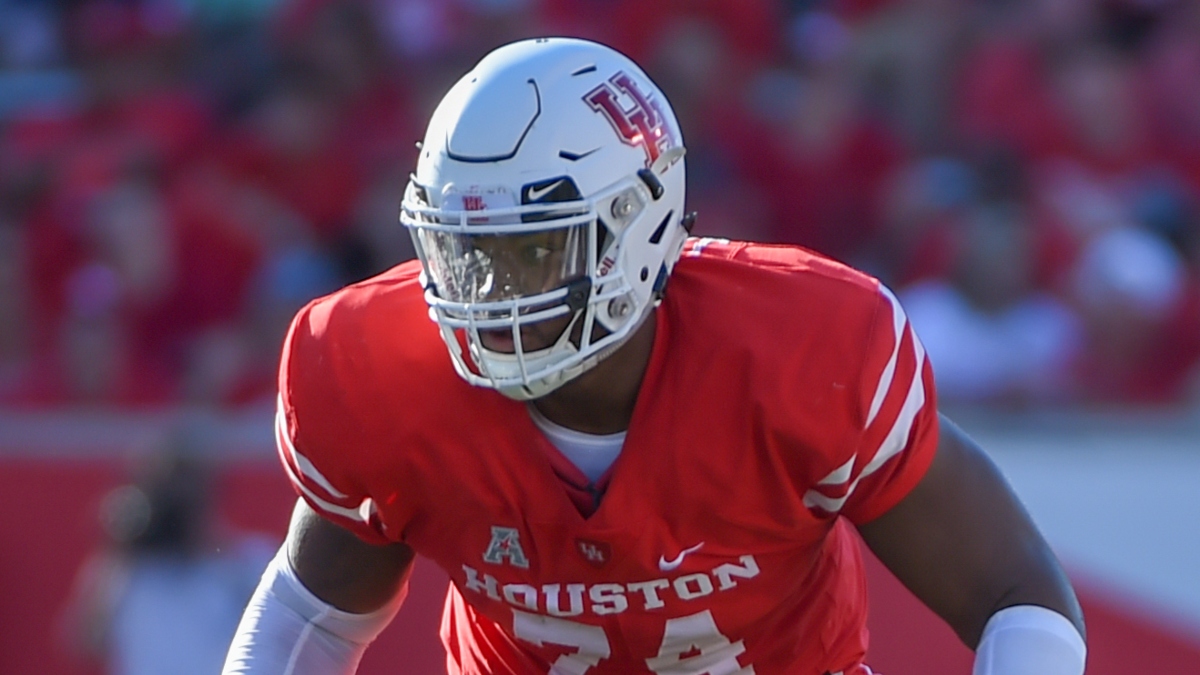
In 2019, Jesse Davis, J'Marcus Webb and Julie'n Davenport all took their turn at left tackle — and not one of them finished the year with a PFF grade of even 60.
The Dolphins have taken steps to shore up their offensive line by adding center Ted Karras and left guard Ereck Flowers via free agency, but it's likely that their 2020 Week 1 left tackle is not currently on the roster.
The Dolphins have so many needs on both offense and defense that it's hard to predict what they'll do at No. 18, but they need a tackle, and this is a good spot to grab one.
19. Raiders*: A.J. Terrell, CB, Clemson
- Height: 6’1” | Weight: 195 pounds
- 40-yard dash: 4.42 seconds
- 2020 Age: 22 | Class: Junior
- Recruitment Stars: 4-5
- Projected Draft Rounds: 1-2
*Pick via Bears
For months, I had linebacker Kenneth Murray (Oklahoma) slotted to the Raiders, but after they signed free agents Cory Littleton and Nick Kwiatkoski to three-year deals, I doubt they're going to invest significant draft capital into the position. So I've pivoted to cornerback.
The Raiders have 2019 second-rounder Trayvon Mullen to man one perimeter spot, but No. 1 cornerback Daryl Worley is a free agent, and the team is seemingly content to let him walk. And it's probably too generous to call Worley a "No. 1 cornerback" anyway. He was the team's top corner by default. And Lamarcus Joyner — a converted free safety — was horrendous as the team's primary slot defender last year (42.8 PFF coverage grade).
The Raiders need an upgrade at corner, and Terrell is a nice option.
A two-year starter with good athleticism and great length, Terrell has the ability to play in most schemes but is probably best as a press-man defender. Because of his size, he can match up with larger receivers, but he can still hang with smaller, faster wideouts because of his speed.
Terrell isn't much of a playmaker: In his two years as a starter, he managed a modest five interceptions across 28 games. He's not the kind of defender quarterbacks fear to target, but rarely is he exposed in one-on-one situations. At a minimum, he's almost certainly an upgrade on Worley and Joyner.
In 2019, Terrell held route runners to 23 receptions on 426 coverage snaps, and in each of his two final campaigns, he had a PFF coverage of at least 80. He's an NFL starter.
[Our Favorite Value Bets for the 2020 NFL Draft]
20. Jaguars*: Jordan Love, QB, Utah State
- Height: 6’4” | Weight: 224 pounds
- 40-yard dash: 4.74 seconds
- 2020 Age: 22 | Class: Redshirt Junior
- Recruitment Stars: 2-3
- Projected Draft Rounds: 1-2
*Pick via Rams
I was tempted to move Love out of Round 1 altogether in this version, but I just couldn't do it because I do think he will probably go on Day 1.
I really don't like this pick: It's basically a placeholder. I need to put Love somewhere in Round 1, and No. 20 to the Jags might work. It's hard to know who to mock to them here anyway because they have so many needs, and it's not as if they're clearly set at quarterback. Maybe — just maybe — they're not sold on the idea that second-year sixth-round quarterback Gardner Minshew is a long-term option?
And maybe they'll trade down and another team will move up the board to get Love.
I really don't know.
I don't think Love should be drafted in Round 1 — but I said the same thing two years ago about Josh Allen and last year about Daniel Jones, and both were top-10 picks.
Love has great "tools." His arm is strong. He can make all the throws required of an NFL quarterback … except for the accurate ones.
Love looked great in 2018, completing 64.0% of his passes with a 9.4 AY/A and 32-6 TD:INT ratio. But he massively regressed in 2019.
There are, of course, extenuating circumstances. There always are. After the 2018 season, HC Matt Wells left for Texas Tech, and new HC Gary Andersen tried to run Wells' offense so that Love wouldn't need to learn a new scheme.
Basically, that meant Love was playing for a coach who didn't know what he was doing. And most of the offensive starters from the 2018 season graduated, so Love was playing with new guys in 2019.
It's easy to see why and how Love's final college season underwhelmed.
But here's the thing about postmortem analysis: The body is still dead.
Love was bad in 2019. There's no getting around it. His completion percentage dropped to 61.9%. His AY/A plummeted to 6.4. And his interception total screamed up to a nation-high 17 as his touchdown total sagged to 20.
I think it's generous to call him even a project. When optimistic evaluators see Love, they think of a raw Patrick Mahomes. But that's not who Love is. He lacks Mahomes' improvisational wizardry — his consistent ability to turn a near sack into a long completion. For Mahomes, a broken play is an opportunity to throw a touchdown. For Love, it's the excuse to throw an interception.
Thanks to his rushing ability (2.4 yards per carry, including sacks), Love will have fantasy utility, just as Josh Allen and Daniel Jones do for the Bills and Giants. Just as Blake Bortles did with the Jaguars.
But that doesn't mean Love will be a good NFL quarterback. I'd bet that he won't be.
Read more about why I wouldn't take Love in any dynasty rookie draft.
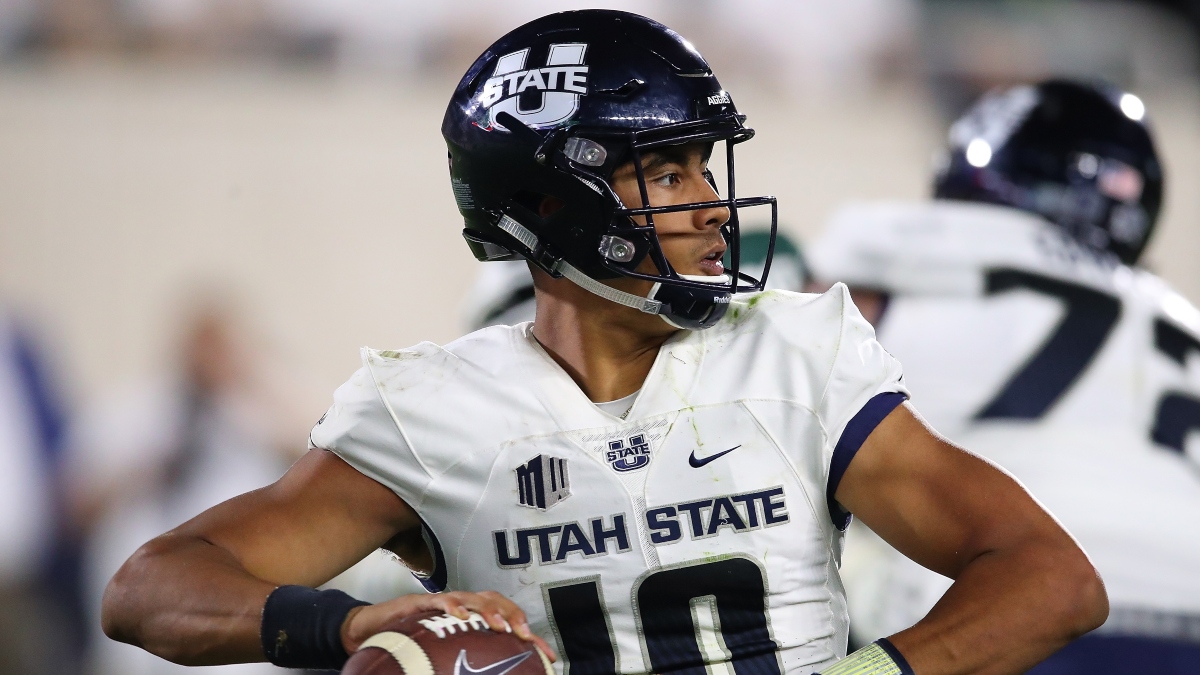
21. Eagles: Justin Jefferson, WR, LSU
- Height: 6’1” | Weight: 202 pounds
- 40-yard dash: 4.43 seconds
- 2020 Age: 21 | Class: Junior
- Recruitment Stars: 3
- Projected Draft Round: 1
As a high-school recruit, Jefferson ran a 4.88-second 40-yard dash at 180 pounds. For a guy to run that slowly and still be a three-star recruit, he must be an exceptionally good football player, and that's true of Jefferson.
What's more is that after three years in LSU's training program, he's now an NFL-caliber athlete. At the combine, he blew away depressed expectations with a 4.43-second 40-yard dash and 37.5-inch vertical and 126-inch broad jumps.
Before the combine, Jefferson was in about half of expert mocks. Now, he's in literally all of them.
Although Jefferson led LSU as a sophomore with 54 receptions, 875 yards and six touchdowns, he didn't burst onto the national scene until his junior year, when he shifted into the slot and benefited from Burrow's transformation into a superstar.
Because Jefferson's 111-1,540-18 campaign coincided with his move to the slot and Burrow's breakout, it might be easy to pigeonhole him as a slot-only, quarterback-dependent receiver.
That's not the case.
Jefferson is better on the interior than the perimeter, and he feasted on zone coverage, but he can line up all across the formation, and he has excellent hands. For a mid-sized receiver, he has near-elite contested-catch ability.
And the Eagles needs a wide receiver.
They have a strong offensive line, and quarterback Carson Wentz, running back Miles Sanders and tight ends Zach Ertz and Dallas Goedert are foundational pieces, but the entire wide receiver unit is a question mark.
Alshon Jeffery is 30 years old going on 45. DeSean Jackson played in just one full game last year. Greg Ward is an undrafted quarterback-turned-slot receiver. And J.J. Arcega-Whiteside massively underwhelmed last year as a rookie.
Jefferson should be a significant upgrade on former slot receiver Nelson Agholor, whom the Eagles allowed to leave via free agency.
Bottom line: Jefferson is a 21-year-old SEC receiver with an above-average physical profile and an elite production history. A guy like that tends to have NFL success.
Read more about where Jefferson ranks in a dynasty rookie class stacked at receiver.
22. Vikings*: Kristian Fulton, CB, LSU
- Height: 6’0” | Weight: 197 pounds
- 40-yard dash: 4.46 seconds
- 2020 Age: 22 | Class: Senior
- Recruitment Stars: 5
- Projected Draft Rounds: 1-2
*Pick via Bills
The Vikings acquired the No. 22 pick by trading disgruntled wide receiver Stefon Diggs to the Bills, so they'll probably need to add a receiver at some point.
But they also need a cornerback, and they have picks Nos. 22 and 25.
Given that the class is deep at receiver and that the Vikings still have two-time Pro-Bowler Adam Thielen at the position, I'll slate a cornerback to the Vikings at No. 22.
Last year at cornerback, the Vikings most often lined up with Xavier Rhodes and Trae Waynes on the perimeter and Mackensie Alexander in the slot. All three of them are now gone. Rhodes signed a one-year deal with the Colts, and Waynes and Alexander joined the Bengals on respective three- and one-year contracts.
All the Vikings have at the position now is 2018 first-rounder Mike Hughes, who went on injured reserve last year in Week 17 with a broken neck. He's expected to be ready for the 2020 season, but who really knows? He broke his neck.
So the Vikings need to draft a cornerback, and Fulton could be their guy.
He's not without his issues: After entering college as one of the most coveted recruits in the country, he was suspended for his sophomore season for using another person's urine on a PED test in order to avoid marijuana detection.
But he returned to the field as a junior, and over the past two seasons, he was one of the most imposing corners in the nation, allowing a completion rate of just 43.2% and only 6.1 yards per target. In 2019, he led the position with 20 forced incompletions.
A true press-man corner with an ideal combination of size and speed, Fulton has the potential to be for the Vikings what they thought Rhodes was a few years ago: A shadow corner capable of matching up with opposing big-bodied No. 1 receivers.

23. Patriots: A.J. Epenesa, EDGE, Iowa
- Height: 6’5” | Weight: 275 pounds
- 40-yard dash: 5.04 seconds
- 2020 Age: 22 | Class: Junior
- Recruitment Stars: 4-5
- Projected Draft Rounds: 1-2
It's impossible to know what the Pats will do here. Although I have Epenesa going to them at No. 23, I could seem trading out of Round 1 altogether.
But if they keep this pick, Epenesa seems like the kind of player they'd draft. He's a workmanlike no-frills prospect who's a better football player than athlete.
Months ago, Epenesa was commonly mocked around picks Nos. 13-22, but after a nondescript combine, he has fallen down the draft board.
But it's not as if he's a nonathlete: He's just not exceptionally athletic. He is, however, a detail-oriented and technically sound edge rusher who plays with immense power and does his job every single snap.
He's capable against the run, and he offers scheme optionality with the size to play as a defensive end in a 4-3 or 3-4 defense. In his two seasons as a regular contributor at Iowa, he racked up 22 sacks, 30.5 tackles for loss and eight forced fumbles.
Epenesa is the kind of football player other football players love, and he could be the anchor of a defensive line for a decade.
[Best Longshot Bets for the NFL Draft]
24. Saints: Kenneth Murray, LB, Oklahoma
- Height: 6’2” | Weight: 241 pounds
- 40-yard dash: 4.52 seconds
- 2020 Age: 22 | Class: Junior
- Recruitment Stars: 3-4
- Projected Draft Round: 1
Although a couple sharper drafters have the Saints going with a wide receiver at No. 24 — and that would be a good range to select one in this class — the Saints don’t have an obvious need at the position, given that they have Michael Thomas, just signed Emmanuel Sanders and drafted Tre’Quan Smith with a third-round pick two years ago.
But the Saints could use some defensive help, especially at linebacker, where a spot has been vacated by A.J. Klein, who signed with the Bills this offseason.
There might be some debate about this, but to me, the best off-ball linebacker in the class is Murray.
A three-year starter, Murray is widely regarded as a high-character, cerebral player who hits harder than the holy spirit. (That might be the most scout-like sentence I've ever written.)
Although Murray is much more of a run-stopping thumper than a do-it-all backer, he's manageable in pass defense: He had a career-best 80.6 PFF coverage grade last year and has improved each season against the pass.
A playmaking sideline-to-sideline size/speed specimen, Murray should be an NFL starter right away and has the potential for a 10-year career as a defensive signal caller.

25. Vikings: Denzel Mims, WR, Baylor
- Height: 6’3” | Weight: 207 pounds
- 40-yard dash: 4.38 seconds
- 2020 Age: 23 | Class: Senior
- Recruitment Stars: 3-4
- Projected Draft Rounds: 1-2
The Vikings need a wide receiver after trading Diggs this offseason, and I allocated a cornerback to them at No. 22, so here's the spot to get them some pass-catching talent.
There are a few guys other than Mims who could be in play at No. 25: Tee Higgins (Clemson), Jalen Reagor (TCU) and Brandon Aiyuk (Arizona State) have all appeared in more than a few expert drafts.
But of the receivers available, Mims is the most complete.
Unlike Higgins, Mims is an elite athlete, as evidenced by his otherworldly 4.38-second 40-yard dash and position-best 6.66-second three-cone drill.
Unlike Reagor, Mims has the size to compete on contested catches and didn't regress in his final season of college.
And unlike Aiyuk, Mims has multiple seasons of notable production at the FBS level (61-1,087-8 receiving in 2017; 66-1,020-12 receiving in 2019).
Mims isn't a polished receiver. Coming from Baylor, he has a limited route tree, and over the past two seasons, he's had an unsightly 12.9% drop rate (per PFF).
If he wins in the NFL, it won't be because he's a smooth technician with jaw-dropping routes. It will be because he's just so dominant as an athlete and aggressive at the catch point: In 2019, he finished No. 2 in the nation with 20 contested catches.
For a Vikings team that might be looking for the downfield playmaking it used to get from Diggs, Mims is a reasonable first-round selection.
Read more about Mims' fantasy ceiling ahead of dynasty rookie drafts.
26. Dolphins*: Xavier McKinney, S, Alabama
- Height: 6’0” | Weight: 201 pounds
- 40-yard dash: 4.63 seconds
- 2020 Age: NA | Class: Junior
- Recruitment Stars: 4
- Projected Draft Round: 1
*Pick via Texans
After a quarterback and left tackle, what do you get the team that needs everything?
The Dolphins could look to solidify their offensive line further by drafting another tackle or perhaps an interior lineman like center/guard Cesar Ruiz (Michigan), but it might be weird to draft two tackles in Round 1 — which one would play on the left side? — and No. 26 still feels a little early for Ruiz.
Plus, the Dolphins have lots of other needs, especially on defense. A case could be made for linebacker Patrick Queen (LSU), but after trading away Minkah Fitzpatrick last year, the Dolphins need a safety, and McKinney fits this general draft range.
And he's a natural Fitzpatrick replacement in Miami given that, over the past two years, McKinney played the “Minkah” role in the Alabama defense.
Although he’s not as accomplished as his former college teammate, McKinney will probably be the first safety selected thanks to his ability to defend in the slot, in the box and deep downfield.
McKinney is the most well-rounded safety in the class.

27. Seahawks: Austin Jackson, OT, USC
- Height: 6’5” | Weight: 322 pounds
- 40-yard dash: 5.07 seconds
- 2020 Age: 21 | Class: Junior
- Recruitment Stars: 4-5
- Projected Draft Rounds: 1-2
It’s almost impossible to have any sense of what the Seahawks will do at No. 27. Two years ago, they made running back Rashaad Penny a surprise first-rounder at No. 27. Last year, they reached for edge defender L.J. Collier at No. 29.
And it wouldn't be surprising at all to see the Seahawks trade out of Round 1 entirely.
If they keep this pick, I think they should go offense.
They've solidified their secondary over the past year by cheaply acquiring cornerback Quinton Dunbar and safety Quandre Diggs via trade. And for the defensive line, they drafted Collier last year and just re-signed Bruce Irvin, who played with the team in 2012-15 and last year had 8.5 sacks and 16 quarterback hits in 13 games with the Panthers.
Their defense isn't the feared unit it once was, but it's also not a liability. The Seahawks have been able to rebuild it on the fly and don't need to invest another first-rounder into it after doing so last year.
So that puts me on the offensive line, where the Seahawks still need to improve. They have Pro-Bowl left tackle Duane Brown, but he's 34 years old and his contract expires in two years. They recently signed tackle Brandon Shell away from the Jets, but his contract is just for two years and backup-level money.
They need another tackle, preferably one with upside, youth and the strong probability of still being in the league and on their team after the 2021 season.
Jackson fits that description. I don't want to say that he's exactly like two-time All-Pro Tyron Smith — his USC forefather — but he looks a lot like Smith the 2011 draft prospect in terms of size, athleticism, age, college playing experience and NFL potential.
Like Smith, Jackson will likely play at right tackle early in his career before fulfilling his destiny and switching to the left side. Smith has the power to play at right tackle and the length to play at left tackle. He's raw, but he's not yet 21 years old, and he's talented enough to play in any type of scheme.
Jackson is a great pick at No. 27.
[Our Staff's Favorite Quarterback Props for the 2020 NFL Draft]
28. Ravens: Patrick Queen, LB, LSU
- Height: 6’0” | Weight: 229 pounds
- 40-yard dash: 4.50 seconds
- 2020 Age: 21 | Class: Junior
- Recruitment Stars: 4
- Projected Draft Round: 1
Perennial Pro-Bowl right guard Marshal Yanda retired this offseason, so the Ravens could look to replace him with Ruiz, who looks like the top interior lineman in the class — but I'm leaning toward the defense in this spot.
And more to the point, Queen is a player I need to get into the Round 1 mock, and No. 28 fits his general draft range. Plus, the Ravens could use an upgrade at inside linebacker, where L.J. Fort and Chris Board are ostensibly slated to start in 2020.
Fort is a 30-year-old journeyman who started eight games for the first time in his career last season. Board is a third-year undrafted rotational player.
The Ravens can do better.
In Queen, they get an immediate starter and precocious up-and-comer with All-Pro potential. More of a safety than a pure linebacker, Queen will need to add more muscle and refine his technique in order not to be pushed around in the running game.
But he's a strong pass defender — he had an 82.0 PFF coverage grade last year in just his first full season of as a starter — and his ability to match up with running backs out of the backfield and tight ends in the slot will give the Ravens defense a real edge.
A running back by trade, Queen didn't start as a linebacker until his final high-school season. Once he learns more of the position's subtleties, he could be nearly unstoppable.
29. Titans: Yetur Gross-Matos, EDGE, Penn State
- Height: 6’5” | Weight: 266 pounds
- 2020 Age: 22 | Class: Junior
- Recruitment Stars: 4
- Projected Draft Rounds: 1-2
Given that they played in the AFC Championship last season and actually had a 17-7 lead in the second quarter, the Titans don’t have many significant weaknesses.
On offense, 10 of their 11 projected starters had PFF grades of at least 70 last year. That’s outstanding.
On defense, though, they aren’t as stout, especially at edge, so I'm looking at that side of the ball instead of a position like offensive tackle.
The team let Cameron Wake walk in free agency, and he missed most of the 2019 season with a knee injury anyway. The Titans need a player to pair with 2018 second-rounder Harold Landry, and Gross-Matos is a strong option.

In his two years as a starter, Gross-Matos totaled 17.5 sacks and 35 tackles for loss. While he doesn't have elite athleticism or pass-rushing skills, Gross-Matos is above average at almost everything, and he has exhibited steady improvement each season.
Perhaps most importantly, he doesn't make big mistakes. He rarely is dominated by an offensive lineman. Although he's unlikely to make an immediate NFL impact, Gross-Matos could develop into a Pro-Bowl producer by the end of his rookie contract.
30. Packers: Tee Higgins, WR, Clemson
- Height: 6’4” | Weight: 216 pounds
- 40-yard dash: 4.54 seconds (pro day)
- 2020 Age: 21 | Class: Junior
- Recruitment Stars: 4-5
- Projected Draft Rounds: 1-2
After not working out at the combine and then displaying mediocre athleticism at his pro day, Higgins has seen his draft stock drop precipitously.
In mid-February mocks, Higgins was a locked-in top-four receiver. Now, he has been jumped by Jefferson and Mims and is competing with the likes of Jalen Reagor (TCU), Brandon Aiyuk (Arizona State) and maybe even Laviska Shenault Jr. (Colorado) to get one of the final Round 1 spots in a handful of drafts.
But I still think he has a decent chance to sneak into Day 1.
The Packers take a receiver at No. 30 in the supermajority of expert mocks, and it's easy to see why: They need to give aging franchise quarterback Aaron Rodgers more offensive support, specifically at wide receiver. Aside from Davante Adams, the Packers lack a reliable pass-catching presence.
And this is a great class for drafting a wide receiver. Even at No. 30, the Packers can get a guy with true difference-making ability — and that guy is T.E.E. Higgins.
It's LOL adorable that #NFLTwitter evaluators think Higgins' mediocre pro day matters. It will likely impact where he's drafted, but I still expect him to have NFL success.
Dabo Swinney played receiver in college and started out at Clemson as the wide receivers coach. His eye for talent at the position is unparalleled. If a guy has the official Swinney imprimatur, he's likely to exceed expectations in the NFL.
Of all the Clemson receivers Swinney has had a hand in recruiting to the program, here are the six to enter the NFL as top-150 draft selections.
- 1.04 (2014): Sammy Watkins – 1,048 yards, nine touchdowns in second season
- 1.07 (2017): Mike Williams – 11 touchdowns in second season, 1,003 yards in third season
- 1.27 (2013): DeAndre Hopkins – five 1,000-yard campaigns and three All-Pro selections
- 4.108 (2010): Jacoby Ford – 625 yards, seven touchdowns as a rookie with limited playing time
- 4.118 (2014): Martavis Bryant – 1,102 yards, 14 touchdowns in first 16 NFL games
- 5.149 (2019): Hunter Renfrow – 504 yards, four touchdowns in final eight games of rookie season
I defy you to name another college program that has so reliably produced NFL-ready receivers over the past decade.
Alabama? Kevin Norwood (4.123, 2014) and ArDarius Stewart (3.79, 2017) beg to differ. Ohio State? DeVier Posey (3.68, 2012) and Devin Smith (2.37, 2015) think otherwise. USC? Patrick Turner (3.87, 2009), Damian Williams (3.77, 2010) and Marqise Lee (2.39, 2014) laugh at you.
And timed athleticism is extremely overrated for wide receivers, especially for big guys with a respectable amount of draft capital and good college production (Higgins is 118-2,103-25 receiving, 1-36-1 rushing over the past two years).
Based on age, size, speed, college production and likely draft range, here are the five NFL prospects of the past decade to whom Higgins is most comparable:
- Courtland Sutton: 2.40 (2018) – 6'3" | 218 pounds | 4.54-second 40 time
- JuJu Smith-Schuster: 2.62 (2017) – 6'1" | 215 pounds | 4.54-second 40 time
- Davante Adams: 2.53 (2014) – 6'1" | 212 pounds | 4.56-second 40 time
- Allen Robinson: 2.61 (2014) – 6'2" | 220 pounds | 4.60-second 40 time
- DeAndre Hopkins: 1.27 (2013) – 6'1" | 214 pounds | 4.57-second 40 time
If the Packers have the opportunity to draft Davante 2.0 at No. 30, do you think they'll do it?
Some tape-grinding enthusiasts think that Higgins is too soft to succeed in the NFL. They say he lacks the physicality necessary to beat NFL corners.
Maybe. I don't know.
I just know it seems pretty stupid to think that a highly-recruited and productive 21-year-old big-bodied Clemson receiver won't be good as a professional.
Read more about how Higgins projects in this stacked receiver class.

31. 49ers: Trevon Diggs, CB, Alabama
- Height: 6’1” | Weight: 205 pounds
- 2020 Age: 22 | Class: Senior
- Recruitment Stars: 4
- Projected Draft Rounds: 1-2
It's hard to know what to do with the 49ers because their roster is strong, which means they can afford to draft more for value and less for need — and they also have a pick at No. 13. But many expert mockers have the 49ers taking a cornerback at some point in Round 1, and that makes sense.
No. 1 cornerback Richard Sherman is 32 years old and in the final year of his contract.
Across from Sherman, it's uncertain if the team will go with special teamer-turned-postseason starter Emmanuel Moseley or starter-turned-bench fodder Ahkello Witherspoon, but either way, it might not matter beyond 2020: Moseley is on a one-year contract, and Witherspoon is in the final year of his deal.
As for slot corner K'Waun Williams, he had the option on his contract exercised this offseason — but like Sherman, Moseley and Witherspoon, he too is slated to be a free agent next year.
The team just re-signed the potential-laden but injury-stricken former Pro-Bowler Jason Verrett — but he was on injured reserve for almost the entire 2019 season, and he has played just six games over the past three years. He cannot be relied on. Plus — and, please, stop me if you've heard this before — he's on a one-year deal.
The top five corners on the 49ers roster: All of them will need new contracts if they are to stay with the team.
Clearly, some — perhaps most — of them will not be with the 49ers in 2021, so they would do well to draft a corner now, and Diggs is a nice option.
A high-school receiver, Diggs transitioned fully to defense as a sophomore and became a starter as a junior. As a senior, he led Alabama with eight pass breakups and allowed a completion rate of only 42.3% on his way to earning a 90.1 PFF coverage grade.
A physical press-man defender with great size and a receiver's instincts, Diggs is almost certainly an upgrade on Moseley and Witherspoon on the perimeter.
32. Chiefs: Cesar Ruiz, C/G, Michigan
- Height: 6’3” | Weight: 307 pounds
- 40-yard dash: 5.08 seconds
- 2020 Age: 21 | Class: Junior
- Recruitment Stars: 3-4
- Projected Draft Rounds: 1-2
In my previous version of the mock, I had cornerback Jeff Gladney (TCU) going to the Chiefs at No. 32 — and that pick made sense, because the Chiefs still need help on defense and at corner in particular — but I need to get Ruiz into Round 1.
Ruiz is in a supermajority of expert mocks, whereas Gladney wasn't invited to participate in the "digital green room" for the draft — which is a bad sign.
So I'm going with Ruiz.
With the speed to play center and the strength to play guard, he will be an automatic NFL starter as a rookie, and the Chiefs could certainly use him.
Center Austin Reiter is in the final year of his contract, and last year was his first as a starter. He's replaceable. Right guard Laurent Duvernay-Tardif is yet to play a full season in five years as a starter, and at 29 years old, he's entering what could be his final season with the team. And left guard Andrew Wylie is on a one-year contract.
At worst, Ruiz is quality depth as a rookie and a future starter in his second season. At best, Ruiz is an immediate upgrade on Reiter and an instant starter who becomes the long-term pivot for quarterback Patrick Mahomes' offensive line.
More 2020 NFL Draft Betting Picks
- Mock Draft (Version 3) & Prop Picks
- Total QBs Drafted in Round 1
- How to Bet the Top 3 Picks
- QB Tua Tagovailoa’s Draft Position
- First Wide Receiver to Be Drafted
- First Running Back to Be Drafted
- First Tight End to Be Drafted
- First Offensive Lineman to Be Drafted
- Second Offensive Player to Be Drafted
- Exact Order of Top 3 Picks
- Second Quarterback to Be Drafted
- First Safety to Be Drafted
- First Player Drafted by Giants
- WR Jerry Jeudy’s Draft Position & to the Jets
- First Player Drafted: Offense vs. Defense, Picks 1-5
- First Player Drafted: Offense vs. Defense, Picks 6-10
- First Player Drafted: Offense vs. Defense, Picks 11-15
- First Player Drafted: Offense vs. Defense, Picks 16-20
- First Player Drafted: Offense vs. Defense, Picks 21-25
- First Player Drafted: Offense vs. Defense, Picks 26-30
- First Player Drafted: Offense vs. Defense, Picks 31-32
Matthew Freedman is the Editor-in-Chief of FantasyLabs, part of The Action Network.















